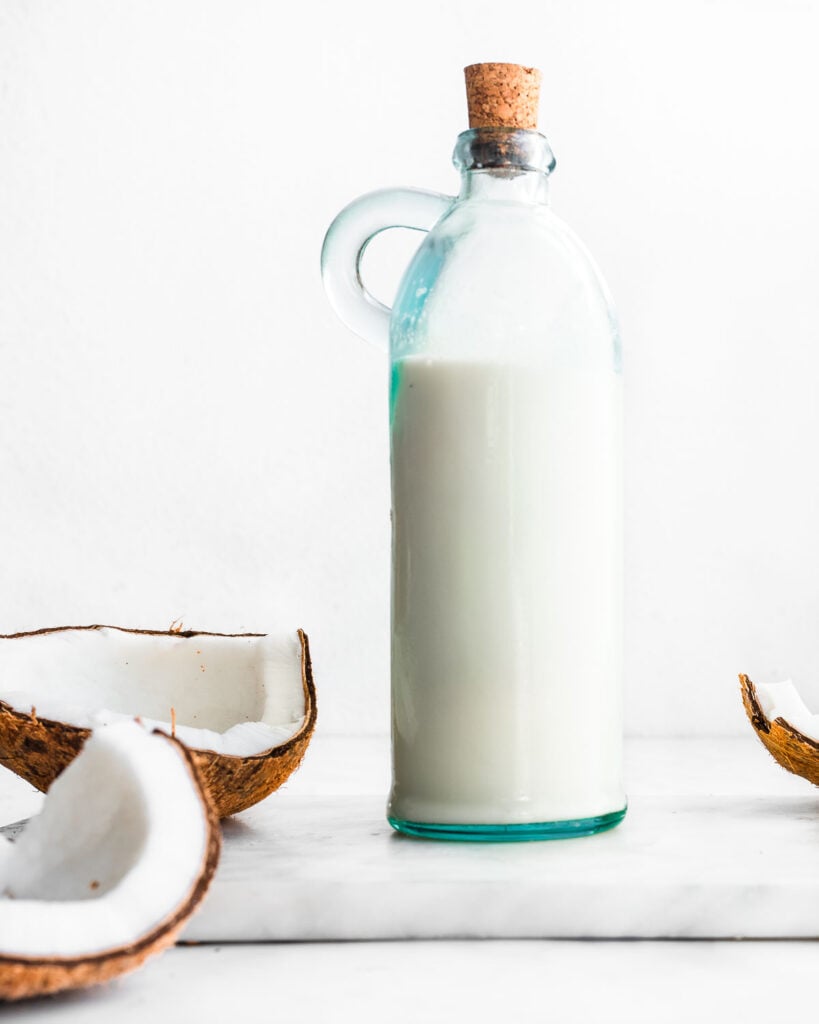Homemade coconut milk tastes fresh and delicate with a rich component thanks to the plentiful natural oils it contains, and more delicious than any canned variety you can buy at the store. It's also easy to make with a little time and patience.
Jump to Recipe | What is it? | How's it made? | Tips | Variations

What is it?
Coconut milk is the creamy, opaque liquid that you extract after blending coconut meat with a small amount of water. It is sweet, mild in flavor, and deliciously rich.
You can use it as an alternative to dairy if you're sensitive to compounds such as lactose or casein, and it also has a long tradition of use in Asian and South Pacific cookery.
How is it made?
Coconut milk is fairly easy to make at home, and the process for both commercial and homemade versions begins the same. You start by separating the coconut flesh from the husk, grating or blending it into small chunks with water, next you'll squeeze and strain the meat and water mixture to extract the milk.
- Traditionally, you split a brown coconut and then scrape away and reserving the white flesh which is then mixed with water, squeezed, and strained.
- Commercial coconut milk is prepared through mechanized production which involves separating the white flesh from the husk, and grating or pressing it to extract the milk. Additives such as gums and preservatives are often added to the liquid before it's canned.
- To make it at home with fresh coconut, you can follow the traditional method by using a coconut scraper, or by prying the white flesh from the coconut husk and blending it with water in a high-speed blender before straining and serving.
- To make it at home with dried coconut, you'll simply blend dried coconut with hot water in a blender, and then strain and serve.
Tips for making coconut milk
Homemade coconut milk needs only two ingredients: coconut and water. And while the process is simple, you'll need some special pieces of kitchen equipment in order to make it such as a high-speed blender.
- Use mature brown coconuts and reserve young green coconuts for making coconut water and coconut yogurt. It also has a fresher, richer flavor than
- Use hot water as it will extract the coconut's beneficial oils more easily, resulting in richer flavor and texture.
- Remove the rough husk, but it's okay if a bit of the brown hull remains. The thin layer of brown hull that surrounds the fresh coconut meat has no impact on flavor or texture.
- If you make it regularly, invest in a coconut grater as well as a coconut drill. They're super affordable and the traditional tools of choice.
Variations
Use dried coconut by blending 2 cups dried, unsweetened coconut with 3 cups hot water. Next, follow the steps for straining listed above.
Add dates for sweetness. While homemade fresh coconut milk is naturally sweet, you may wish to sweeten it further by adding 2 to 3 pitted dates to the coconut meat in the blender. Then, strain as you normally would.
Add spices such as vanilla, cardamom, or cacao. If you'd prefer to give a little lift and flavor to your coconut milk, you can blend vanilla bean, cardamom, cacao, or other herbs in with the coconut, straining as you normally would.






Dave says
I really like the idea of the addition of the dates!
hajia says
its really delicious to drink I tried it thank you
pix says
after piercing the "eyes" of the coconut and draining the water, pop the whole coconut into the freezer for couple of hours. Make it easier to crack open with hammer and the white flesh could be prised out much easier.
Kristyn says
I used this tutorial with great success!! Thank you so much. Can't wait to do it again!!